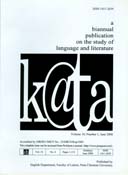Destruction of Bekisar Merah: Antoine Berman’s Deforming Tendencies in The Red Bekisar
DOI:
https://doi.org/10.9744/kata.19.2.41-47Keywords:
translation, negative analysis, deforming tendencies, culture, JavaneseAbstract
Bekisar Merah, a novel by prominent Indonesian writer Ahmad Tohari, had been translated into its English version The Red Bekisar. Being a literary work thick with Javanese culture with all its depth and uniqueness to the global literary world, the original work is compared to the translated work and furthermore analyzed using Antoine Berman’s ‘negative analysis.’ Berman suggested that in translating a foreign text, foreign elements should be kept and not destroyed by familiarizing them to the receiving culture. Using the ‘deforming tendencies’ in his concept, three foreign deforming tendencies can be found in The Red Bekisar : the destruction of underlying network signification, the destruction of the linguistic patterns, and the destruction of vernacular patterns or their exoticization. Through the samples taken and the analysis, it is found that the three deforming tendencies are making drastic changes and even loss to many elements in the novel, such as their meanings, unity, rhythm, degree, coherence in the line of thoughts, and the richness in the foreign elements.
Downloads
References
REFERENCES:
Hassall, T. (2011) Asking What You Want In Indonesian. Bahasa Kita: Indonesian Language Online Resources. Retrieved from http://www.bahasakita.com/asking-for-
what-you-want-in-indonesian/ on June 7, 2016.
Munday, J. (2001). Introducing Translation Studies. New York, NY: Routledge.
Rybicki, J. (2005). Deformative Tendencies. Deformative Tendencies. Retrieved from http://www.ap.krakow.pl/nkja/ptm2/deformative_tendencies.htm on June 7, 2016.
Tohari, A. (2011) Bekisar Merah. Jakarta, Indonesia: Gramedia.
Tohari, A. (2011). Bekisar Merah [The Red Bekisar]. San Mateo, CA: Dalang Publishing.
Woods, G. (2010). Spicing Up Boring Sentences with Clauses and Verbals. For Dummies. Retrieved from http://www.dummies.com/how-to/content/spice-up-boring-sentences-with-clauses-and-verbals.html on June 7, 2016.
Downloads
Published
How to Cite
Issue
Section
License
![]() This work is licensed under a Creative Commons Attribution License
This work is licensed under a Creative Commons Attribution License



.png)
.png)

















